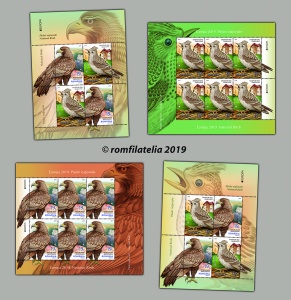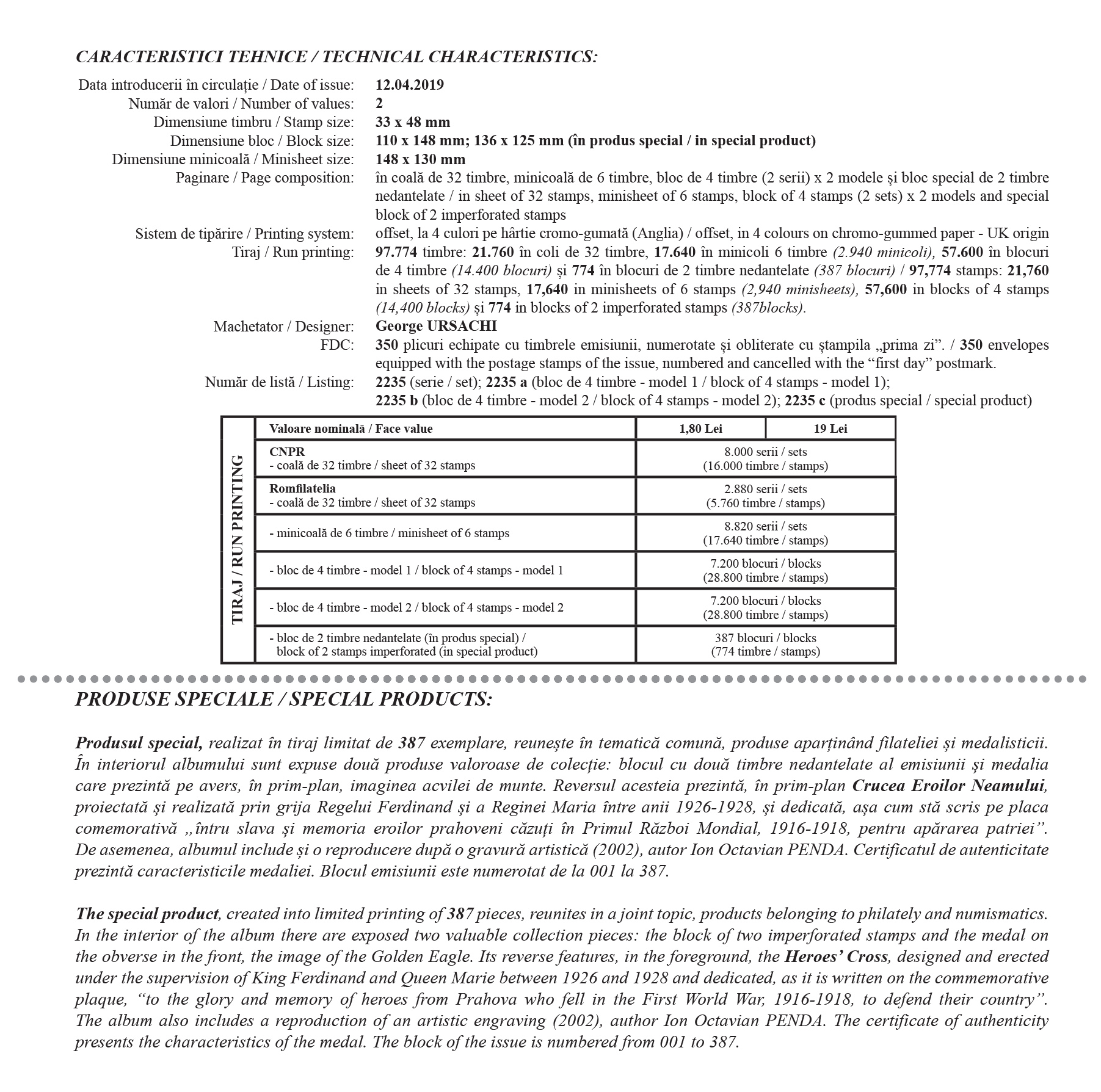For this year, under the title Europa 2019, PostEurop, body of the Universal Postal Union, a United Nations specialized agency, has chosen the theme National Birds, a topic greatly appreciated by collectors.
The two stamps of the postage stamps issue illustrate the Golden Eagle and the Eurasian Skylark.
The first stamp, with the face value of Lei 1.80, illustrates the Eurasian Skylark, and the second stamp with the face value of Lei 19 represents the Golden Eagle.
In addition, the stamps issue is completed by a special philatelic product with a medal having on the obverse in the front the image of The Golden Eagle. Its reverse features, in the foreground, the Heroes’ Cross, designed and erected under the supervision of King Ferdinand and Queen Marie between 1926 and 1928 and dedicated, as it is written on the commemorative plaque, “to the glory and memory of the heroes from Prahova who fell in the First World War, 1916-1918, to defend their country”.
Also, the special philatelic product includes a reproduction of an artistic engraving (2002), author: Ion Octavian PENDA.
The Eurasian Skylark (Alauda arvensis) is a songbird widely spread across Romania, being present from April until the beginning of autumn. It prefers the steppe or the plain habitats with abundant herbaceous vegetation, often being encountered in agricultural land areas.
The colour is generally light brown, with thick and dark spots, with white abdomen and the posterior edge of the wing of whitish colour. On the head it has a crest of a smaller size compared to the skylark, whose crest is more pronounced. The length of the body is 18-19 cm, and the wingspan is 30-36 cm, with a body mass of 45-55 g. The maximum longevity reached in the nature is up to 11 years.
Its birdcalls can be heard from the early hours of the morning, consisting of high notes, repeated in long series. The Eurasian Skylark is even more special, as it is the only bird that sings during its rise at high altitudes, until it can only be spotted by hearing its endless song.
Its arrival symbolizes the setting of spring in the places where it settles that year. Because of its habit of rising in the air and singing in the sky, people felt fascinated by its presence, which is why the Eurasian skylark represented a leitmotif of the Romanian culture, inspiring musical compositions such as George Enescu’s Romanian Rhapsody and numerous legends, being presented either as the daughter of the sun, or the girl who fell in love with the sun.
The Golden Eagle (Aquila chrysaetos) is considered the ancient Carpathian pride alongside the bearded vulture (Gypaetos barbatus), with a wingspan of 190-225 cm, the Golden Eagle is one of the most renowned species of birds of prey on earth. It is mentioned in a lot of Romanian folk legends and stories carefully gathered by Simion Florea Marian in the Romanian Folk Ornithology, published in Cernauti in 1883, where it appears under other popular names such as: pajura, zgripturoaica, pajura imparateasca, vulturoaica, etc.
The Golden Eagle is not necessarily considered a high-mountain bird, some researchers noticed that these species have been forced to leave the beech forest area gradually and to climb in higher areas with lower trophic supply, mainly due to massive forest exploitation of the last century. In the 1950s, only a few dozen pairs nestled in the Romanian Carpathians, mainly on the steep slopes of Bucegi, Retezat and Ceahlau. Also, campaigns to combat wolves with strychnine in the past have led to a drastic drop in flocks, mountain eagles sometimes feeding with animal corpses during heavier winters.
The presence of the image of this bird was intertwined with the history and tradition of many peoples, being since ancient times an ensign, a flag and a symbol of empires and civilizations, and often considered as a symbol of luck.
The “mountain vulture” symbol was related to the historical tradition of Romania, starting from the vulture of the first ruling Basarab house, to the coat of arms of the United Principalities during the reign of Alexandru Ioan Cuza, to the one after the independence was gained during Carol I’s reign, becoming the symbol of Greater Romania. At present, the Romanian State coat of arms has an eagle in the foreground, having the crown of steel of the kings of Romania on its head, but it is also illustrated in the first quadrant of the coat of arms, one in which the coat of arms of Wallachia appears.
Romfilatelia thanks the “Grigore Antipa” National Museum of Natural History from Bucharest, for the documentary support given to this postage stamp issue and the photographer Silviu Matei.




